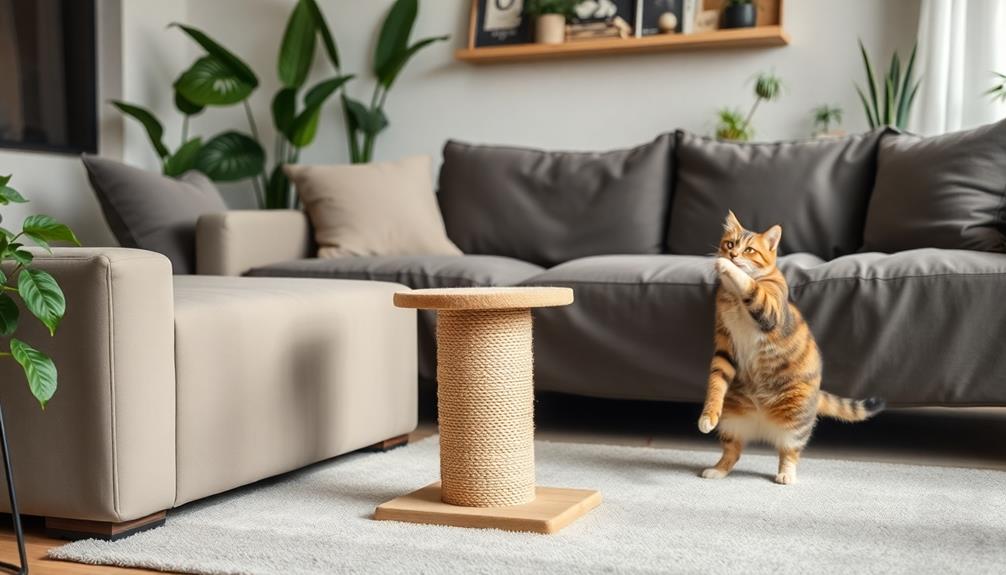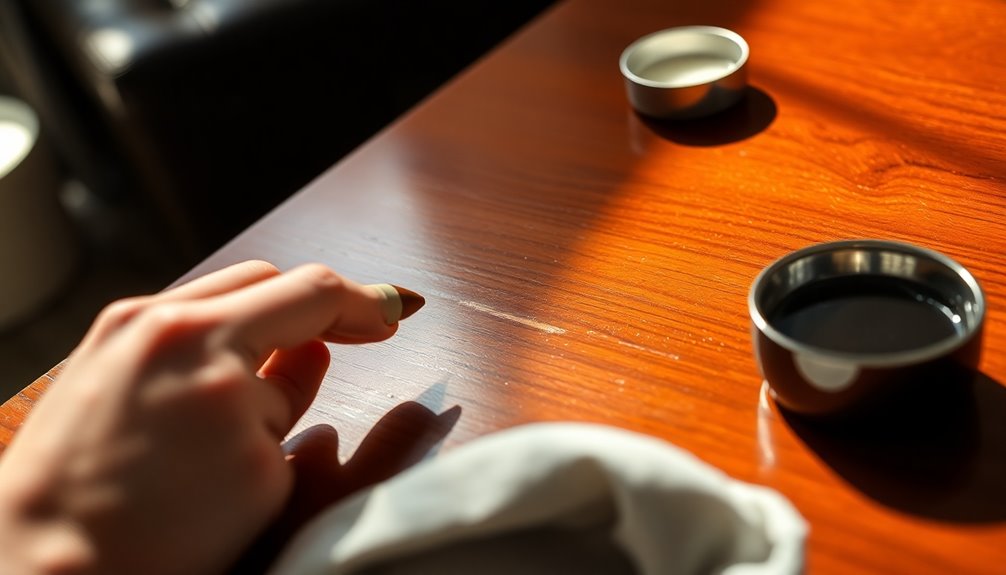To prevent your cat from damaging furniture, it is recommended to provide them with a variety of scratching posts made from different materials such as sisal and cardboard. Position these posts strategically, especially near their favorite lounging areas. Whenever you see your cat using the scratching post, reward them with treats or praise to encourage this behavior. Additionally, you can make your furniture less attractive for scratching by using double-sided tape or citrus sprays as deterrents. Regular nail trimming can also help minimize any damage caused by scratching. Creating a calm environment with interactive toys can help reduce anxiety, ultimately preventing unwanted scratching behaviors. There are various other strategies and products available to address this issue effectively.
Key Takeaways
- Provide various scratching posts in different materials and positions to encourage appropriate scratching behavior.
- Use double-sided sticky tape or citrus sprays on furniture to deter scratching with unpleasant textures and smells.
- Regularly trim your cat's nails every 2-4 weeks to minimize potential damage to furniture.
- Use positive reinforcement techniques, like treats and praise, when your cat uses designated scratching areas.
- Create a stimulating environment with interactive toys and climbing structures to reduce boredom and anxiety-related scratching.
Understanding Cat Scratching Behavior
Understanding your cat's scratching behavior is key to preventing damage to your furniture. Scratching is instinctual, rooted in survival, and serves multiple purposes. It helps your cat maintain healthy claws by shedding old nail sheaths and exposing sharper ones.
Additionally, regular scratching contributes to their overall physical health, promoting exercise and flexibility, which can reduce stress levels. But it's not just about claw health—it's also about marking territory. When your cat scratches, scent glands in their paws release pheromones, signaling ownership and reinforcing their presence in a space.
Each cat has its own preferred scratching style. While many cats gravitate towards vertical surfaces like your sofa or chair legs, others may prefer horizontal options such as carpets or rugs. This variation means you'll need to observe your cat's scratching behavior closely to understand what they like best.
For some cats, the right scratching surface can make all the difference, similar to how specific hamster cage setups cater to different needs. Scratching also provides essential exercise, allowing your cat to stretch and release muscle tension, which can help alleviate anxiety.
Providing Effective Alternatives
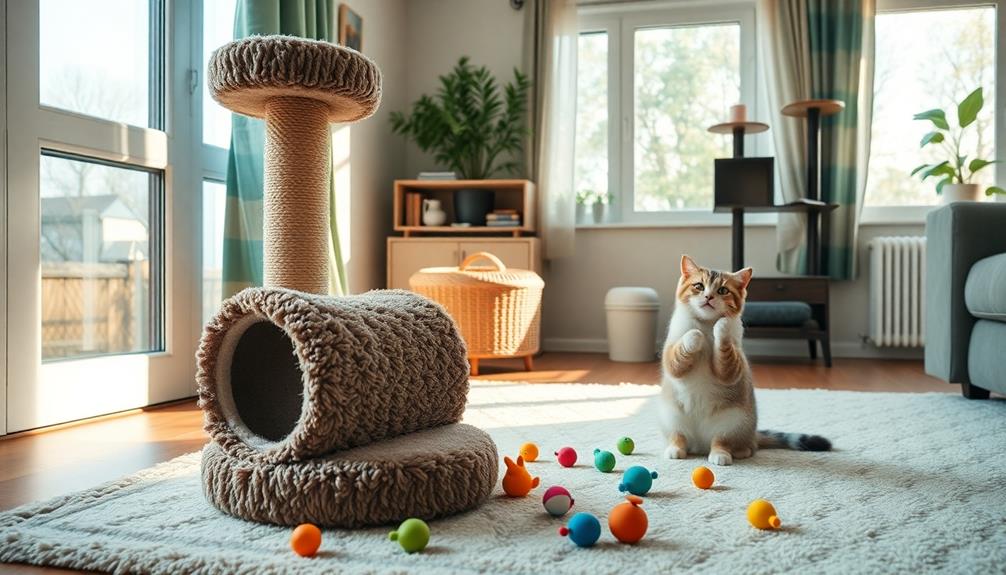
To keep your furniture safe, it's important to provide your cat with effective alternatives for scratching. Start by providing multiple scratching posts made from various materials like sisal, cardboard, and carpet. This caters to your cat's preference and encourages appropriate scratching behavior. Position these posts in high-traffic areas or near their favorite furniture to increase visibility and usage.
Experimenting with horizontal scratching boards can also be beneficial, as some cats prefer flat surfaces over vertical posts. To further motivate your cat, sprinkle catnip on the post or offer treats as positive reinforcement. This helps divert their attention from your furniture and promotes engagement with designated scratching areas.
Here's a quick overview of effective scratching options:
| Material | Positioning | Reinforcement |
|---|---|---|
| Sisal scratching post | Near favorite spots | Catnip on the post |
| Cardboard scratcher | High-traffic areas | Treats as rewards |
| Carpet post | Close to furniture | Playtime near the post |
| Horizontal board | Different room levels | Positive interactions |
Training Techniques for Cats
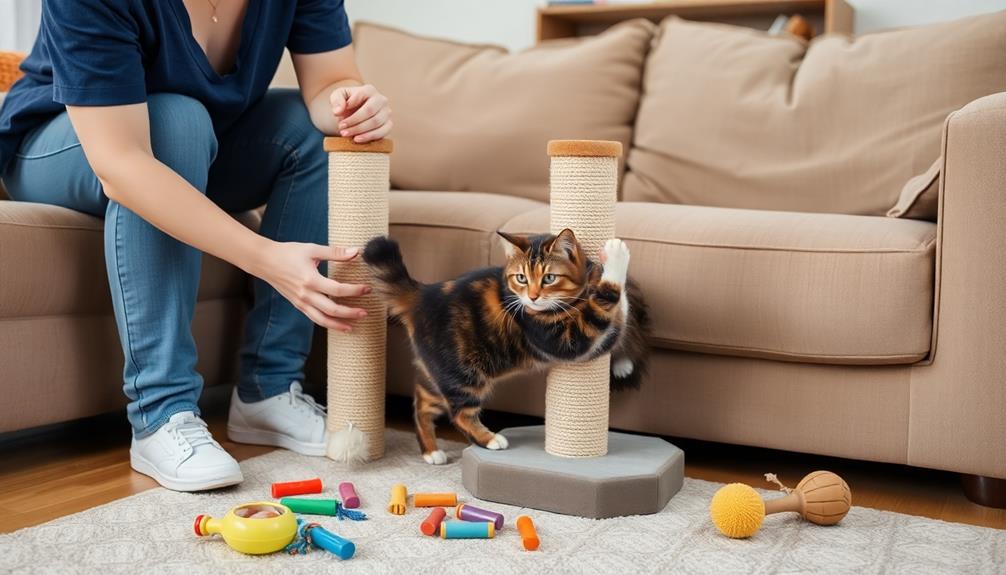
Training your cat to use designated scratching areas can be incredibly rewarding for both you and your furry friend. Start by providing a variety of sturdy scratching posts, ideally placed near the furniture they tend to scratch. This encourages your cat to scratch in appropriate areas.
When you catch your cat using the scratching post, employ positive reinforcement techniques. Treats and praise will help reinforce this behavior, making the scratching post their preferred spot. It's also beneficial to reflect on how creating a safe and engaging environment for your cat can reduce unwanted behaviors, similar to how caregivers manage managing behavioral issues in seniors.
If your cat starts to scratch furniture, gently redirect them with a firm "no" or a clap. This approach helps guide them away without causing fear or anxiety. Regular nail trimming every 2-4 weeks can also minimize potential damage, making your furniture less appealing to scratch.
Experimenting with different scratching surfaces, such as sisal, cardboard, or carpet, allows you to find the texture your cat prefers. This increases the likelihood that they'll choose the designated scratching areas over your furniture.
Making Furniture Less Attractive

Making your furniture less attractive to your cat can greatly reduce unwanted scratching. By implementing a few simple strategies, you can protect your surfaces and keep your furniture looking great.
Start by applying double-sided sticky tape to areas where your cat tends to scratch. This creates an unpleasant texture that most cats dislike. You can also use cat-safe citrus sprays or vinegar to make your furniture smell unappealing to your feline friend.
Additionally, consider integrating natural remedies alongside these strategies, as they can provide an extra layer of deterrent for your cat's scratching behavior common types of cold medications.
Here are a few additional tips to keep in mind:
- Covering furniture with sheets, plastic covers, or aluminum foil can deter scratching and protect your surfaces.
- Regularly cleaning your furniture helps eliminate previous scent marks, reducing the likelihood of your cat returning to scratch.
- Placing textured floor mats around your furniture can redirect their scratching behavior, making the mats more appealing than your furniture.
Addressing Stress and Anxiety
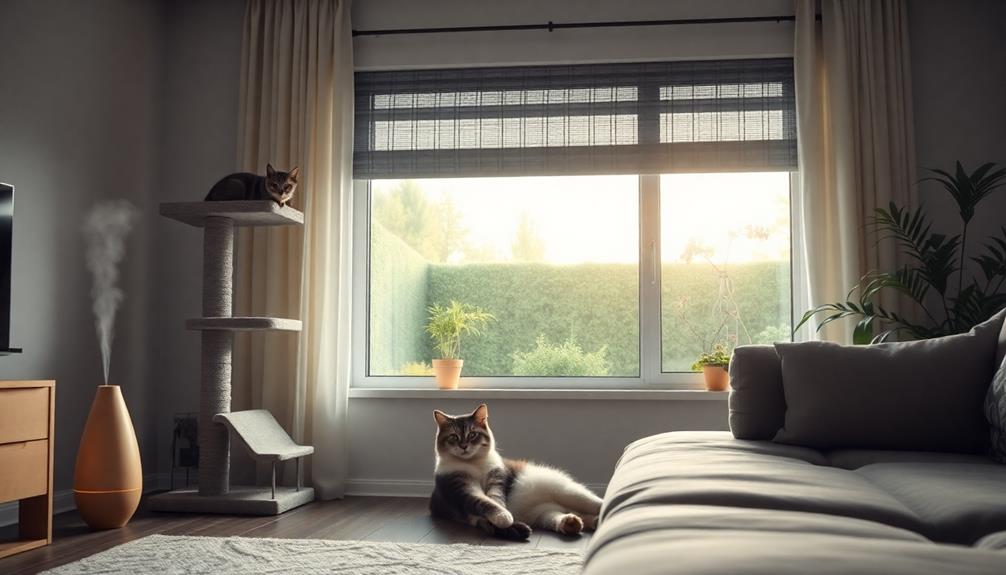
To help your cat stop clawing furniture, it's crucial to identify what stresses them out.
Create safe spaces where they can retreat and feel secure, and consider using calming products tailored for cats.
Identify Stress Triggers
Understanding your cat's stress triggers is essential for curbing unwanted scratching behavior. Scratching can often be a sign of stress or anxiety stemming from changes in their environment or routine.
Identifying specific triggers, such as loud noises or conflicts with other animals, is vital for addressing the underlying causes of this behavior.
To help manage your cat's stress, consider these strategies:
- Create a stimulating environment: Incorporate enrichment activities like interactive play and climbing structures to keep your cat engaged.
- Monitor changes: Pay attention to any new pets, people, or noises that might cause anxiety, and adjust your cat's environment accordingly.
- Utilize calming products: Consider using Feliway pheromone diffusers or supplements to promote a relaxed atmosphere.
Provide Safe Spaces
Creating safe spaces for your cat can greatly alleviate stress and anxiety, which often lead to unwanted scratching. Designate cozy hideaways or quiet areas in your home where your cat can retreat when feeling overwhelmed. These safe spaces can considerably reduce stress and minimize destructive scratching behavior.
Incorporating vertical spaces like cat trees or shelves is also essential. Cats naturally seek height for security, so providing these options allows them to explore their environment while feeling safe. This promotes natural behaviors and lessens the urge to claw your furniture.
Engaging in regular interactive play sessions is another effective way to reduce stress. By providing stimulating toys and activities, you help your cat expend energy and alleviate boredom, which can otherwise contribute to anxiety and scratching.
Use Calming Products
If your cat seems anxious or stressed, using calming products can make a significant difference in their behavior. These products can help reduce anxiety, which often leads to unwanted scratching behavior. One effective option is a pheromone spray, like Feliway, that mimics natural feline scents and creates a sense of security.
Consider these additional calming solutions:
- Herbal calming supplements: Ingredients like valerian or chamomile can promote relaxation and help curb the urge to scratch your furniture.
- Interactive toys: Engaging your cat with toys can provide mental stimulation, reducing boredom and stress, which might otherwise trigger scratching.
- Environmental enrichment: Adding cat trees, window perches, or cozy hideaways can create a more stimulating environment for your cat, further alleviating anxiety.
It's essential to create a calm atmosphere, too, maybe with soft music or white noise.
If your cat's anxiety is severe, consult a veterinarian about prescribed medications.
Products to Protect Furniture
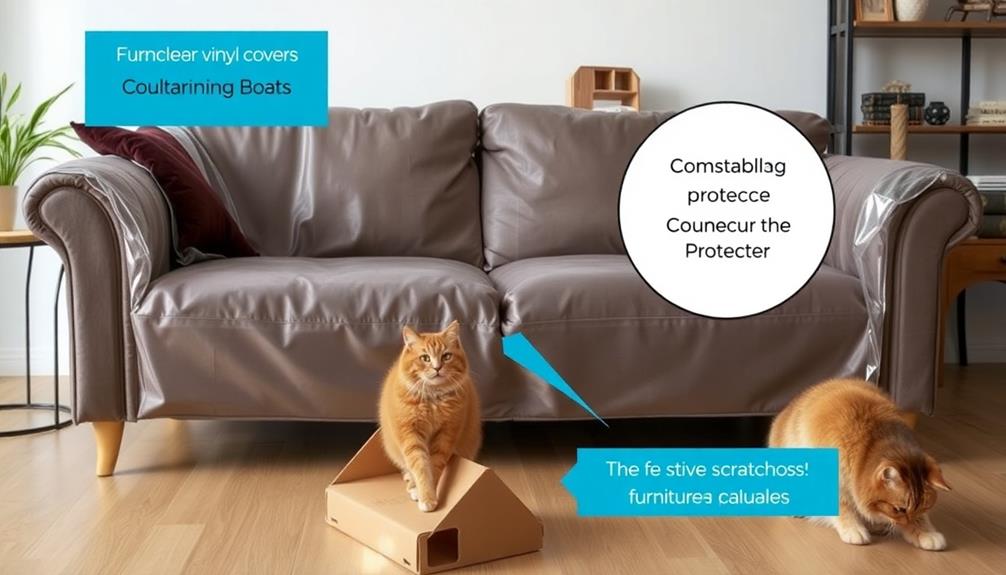
To protect your furniture from scratching, consider using a variety of innovative products designed specifically for this purpose.
Clawguard Furniture Shields are an excellent choice; these durable, transparent vinyl protectors blend seamlessly with your furniture, preventing scratches while maintaining aesthetics.
For a non-aversive solution, try Pioneer Pet Sticky Paws. This double-sided tape adheres well to surfaces and removes easily without leaving residue.
If you're looking for a dual-purpose option, Sofa Scratchers serve as both a protective barrier and a scratching post, fitting snugly against your furniture without the need for tape or pins.
Another effective option is Soft Claws nail caps. These flexible vinyl covers fit over your cat's claws, allowing for natural claw extension while preventing damage to your furniture.
Declawing: Myths and Facts
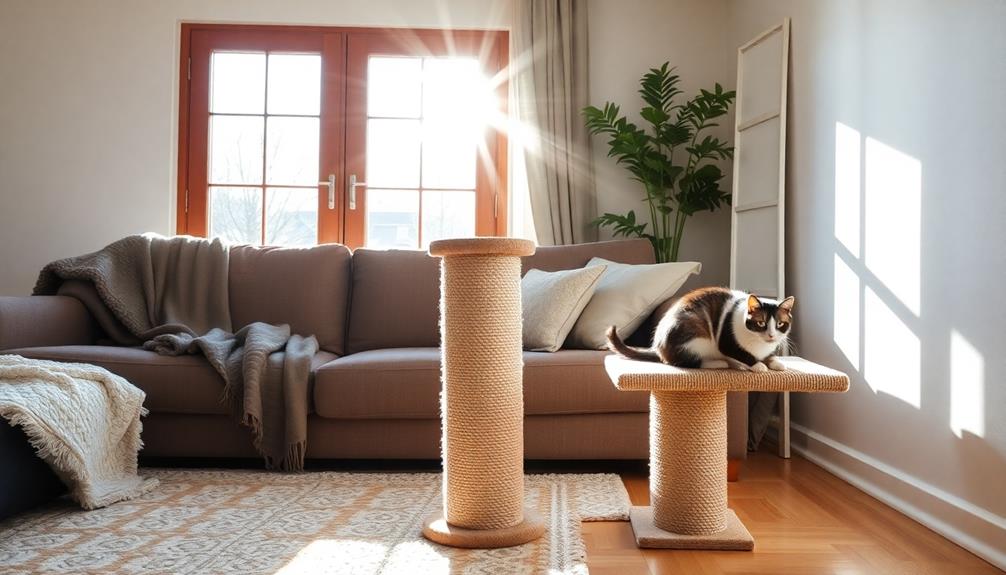
When you consider declawing your cat, it's essential to understand the pain it causes and the potential behavioral changes that follow.
Many people believe declawing will stop scratching, but it often leads to increased biting and stress.
Exploring humane alternatives can help you protect your furniture without putting your cat through unnecessary suffering.
Declawing Causes Pain
Declawing is a painful procedure that goes far beyond simply trimming a cat's nails. Officially known as onychectomy, it involves surgically removing the last bone of each toe, leading to severe pain and significant long-term complications.
Many studies show that declawed cats often suffer from chronic pain, which can manifest in various behavioral issues.
- Declawing doesn't eliminate scratching behavior; cats may still try to scratch or develop new destructive habits.
- This procedure has been banned or restricted in numerous places, including New York, due to ethical concerns regarding its cruelty.
- There are humane solutions available that allow you to manage your cat's scratching without inflicting pain.
Instead of opting for declawing, consider alternatives like regular nail trimming, providing scratching posts, and using soft claw caps.
These solutions respect your cat's natural behavior while protecting your furniture. By understanding the pain associated with declawing, you can make informed, compassionate choices for your feline friend.
Behavioral Impacts of Declawing
The emotional turmoil for cats subjected to declawing often leads to profound behavioral changes. This painful procedure involves amputating the last bone of each toe, resulting in chronic pain.
Many cats become stressed and anxious post-declawing, which can cause them to avoid the litter box or develop a tendency to bite due to discomfort and frustration.
You might think declawing eliminates scratching behavior, but that's a misconception. Instead, it often redirects this natural instinct to other areas, like your furniture or even your body.
Without claws, cats may feel defenseless and resort to aggressive behaviors, as they lack an essential means of self-expression and protection.
Fortunately, there are alternatives to declawing that effectively manage scratching behavior without these harmful effects.
Regular nail trimming helps keep their claws in check, and claw caps offer a non-invasive way to protect your furniture while allowing your cat to maintain a healthy outlet for their scratching instincts.
Enrichment Activities for Cats
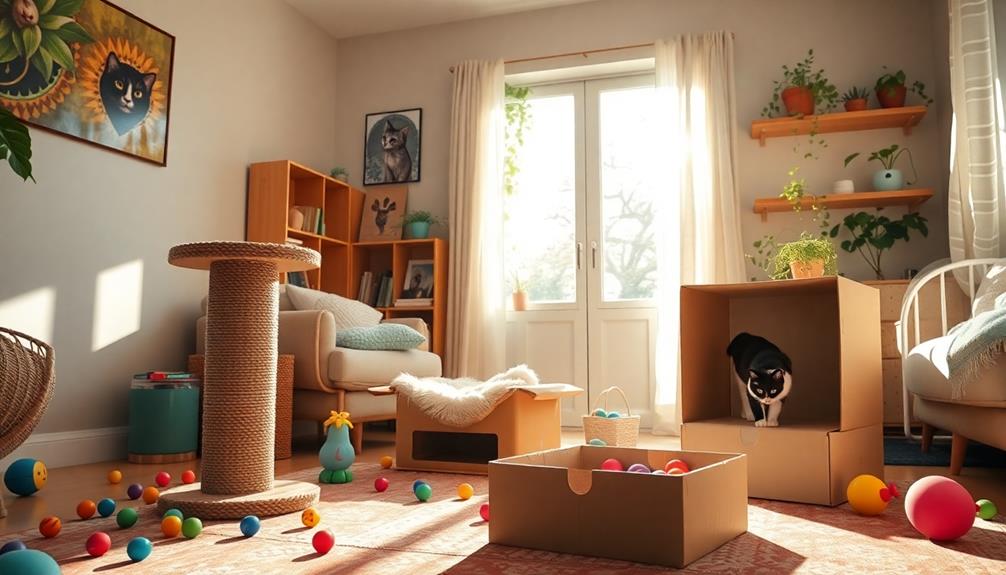
Cats thrive on mental and physical stimulation, making enrichment activities essential for their well-being. To keep your feline friend engaged and happy, consider incorporating a variety of interactive toys into their routine. These toys, like feather wands or laser pointers, can stimulate their hunting instincts and reduce destructive scratching on your furniture.
Aim for daily play sessions of at least 15-20 minutes to alleviate boredom and anxiety.
Creating a designated play area is another effective strategy. Fill this space with scratching posts, toys, and cat trees, providing vertical climbing opportunities that satisfy their natural instincts. This setup not only keeps your cat entertained but also redirects their scratching behavior away from your furniture.
Additionally, incorporating puzzle feeders can mentally stimulate your cat, encouraging them to engage in more constructive activities.
- Set up a dedicated playtime schedule.
- Use a variety of interactive toys to keep things fresh.
- Ascertain your designated play area has plenty of climbing options.
Seeking Professional Help
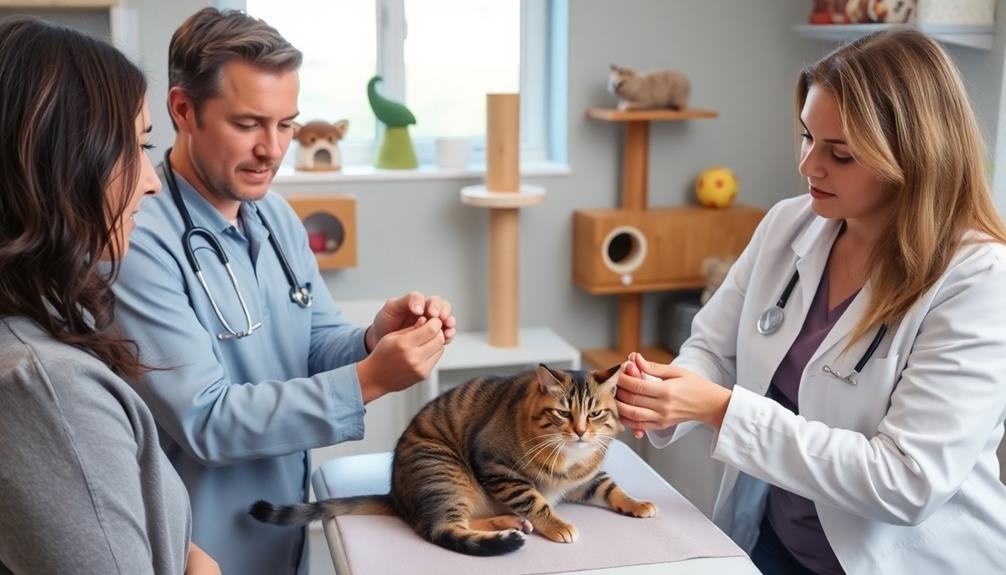
When scratching becomes a persistent problem, seeking professional help can make a significant difference. Consulting a board-certified veterinary behaviorist can provide you with tailored strategies to address your cat's specific scratching behavior.
They'll assess your cat's needs and environment to develop a thorough care plan that may include behavior modification techniques. Veterinary professionals can also prescribe calming supplements to help reduce anxiety, which is often a contributing factor to excessive scratching.
Implementing a behavior modification program can involve structured plans that combine environmental enrichment with appropriate redirection techniques, ensuring your cat has plenty of stimulating activities.
Additionally, joining a local or online cat behavior support group can be invaluable. These groups offer shared experiences and resources that can help you find effective solutions for managing your cat's scratching.
Tapping into the knowledge of others who've faced similar challenges can provide fresh insights and encouragement.
Frequently Asked Questions
What Deters Cats From Scratching Furniture?
To deter cats from scratching furniture, use double-sided tape, citrus sprays, or clear shields. Providing scratching posts and trimming their nails regularly will redirect their behavior, making your furniture less appealing for scratching.
How Do I Stop My Cat From Scratching My Couch?
Imagine your cat happily stretching and scratching a sturdy post instead of your couch. To encourage this, place enticing posts nearby, use sticky tape on the couch, and trim their claws regularly for smoother surfaces.
How Do You Scratch Proof Furniture From Cats?
To scratch-proof your furniture, apply double-sided tape, install claw guards, or drape blankets over surfaces. Use cat-safe sprays for deterrence, and trim your cat's nails regularly to reduce damage potential. Additionally, provide designated scratching posts or pads around the house to give your cat appropriate outlets for its scratching behavior. Rewarding your cat for using these alternatives can reinforce positive habits while protecting furniture from cats. Consistency in training and using a variety of deterrents is key to long-term success.
How Do You Stop Cats From Scratching Furniture DIY?
To stop your cat from scratching furniture DIY, create a sturdy scratching post, use double-sided tape on targeted areas, apply a vinegar-water spray, and place textured mats nearby to redirect their scratching behavior effectively.
Conclusion
By understanding your cat's natural scratching behavior and providing alternatives, you can protect your furniture without resorting to drastic measures. Some might think declawing is a solution, but it can lead to pain and behavioral issues. Instead, focus on training, make your furniture less appealing, and invest in scratchers. Your cat's happiness and your home's harmony can coexist, ensuring both you and your feline friend enjoy a stress-free environment. Embrace the challenge; it's worth it!
